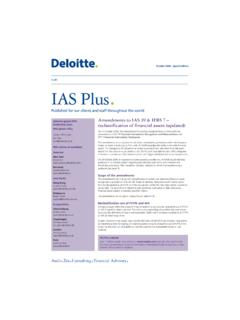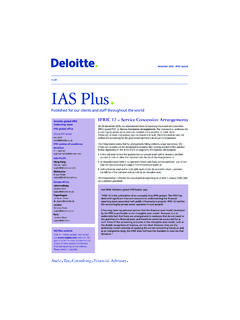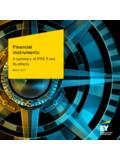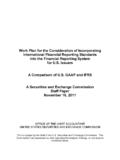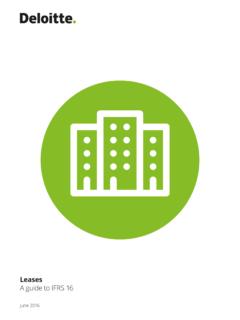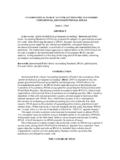Transcription of IFRS in Focus IFRS 9: Financial Instruments – high level ...
1 ifrs Global office April 2016. ifrs in Focus ifrs 9: Financial Instruments high level summary Contents The Bottom Line Background ifrs 9 is effective for annual periods beginning on or after 1 January 2018 and, subject to local endorsement requirements, is available for early adoption. Overview of ifrs 9. The classification and measurement of Financial assets is dependent on the Classification and measurement of Financial contractual cash flows of the asset and the business model within which the Instruments asset is held. Impairment Embedded derivatives are no longer separated from Financial asset host Hedge accounting contracts. Disclosures The new impairment model is based on expected credit losses and applies to debt Instruments at amortised cost or FVTOCI, lease receivables, contract assets Transition to ifrs 9 and certain written loan-commitments and Financial guarantee contracts.
2 A loan loss allowance for either 12-month expected credit losses or lifetime expected credit losses is required for all exposures in scope of the ifrs 9. impairment requirements. Hedge accounting can more closely reflect risk management; with more qualifying hedging Instruments and hedged items. Retrospective assessment of hedge effectiveness is no longer required and the prospective test is now based on the principle of an economic relationship'. Revisions to the accounting treatment for the time value of options, forward points and currency basis spread element of hedging Instruments can reduce profit or loss volatility. Amendments to ifrs 7 Financial Instruments : Disclosures introduces significant additional disclosure requirements when ifrs 9 is applied. For more information please see the following websites: Background ifrs 9 Financial Instruments is the IASB's replacement of IAS 39 Financial Instruments : Recognition and Measurement.
3 The Standard includes requirements for recognition and measurement, impairment, derecognition and general hedge accounting. The version of ifrs 9 issued in 2014 supersedes all previous versions and is mandatorily effective for periods beginning on or after 1 January 2018 with early adoption permitted (subject to local endorsement requirements). For a limited period, previous versions of ifrs 91 may be adopted early, provided the relevant date of initial application is before 1 February 2015 (again, subject to local endorsement requirements). Observation The International Accounting Standards Board (IASB) has published an exposure draft (ED/2015/11) that proposes amendments to ifrs 4 Insurance Contracts that are intended to address concerns about the different effective dates of ifrs 9 Financial Instruments and the forthcoming new insurance contracts standard.
4 The deadline of comments ended on 8 February and at the time of writing the IASB was considering the responses received. The purpose of this publication is to provide a high - level overview of the ifrs 9 requirements, focusing on the areas which are different from IAS 39. The following areas are considered: classification and measurement of Financial assets;. impairment;. classification and measurement of Financial liabilities; and hedge accounting. The derecognition model in ifrs 9 is carried over unchanged from IAS 39 and is therefore not considered further in this paper. Overview of ifrs 9. Classification and measurement of Financial Instruments Initial measurement of Financial Instruments Under ifrs 9 all Financial Instruments are initially measured at fair value plus or minus, in the case of a Financial asset or Financial liability not at fair value through profit or loss, transaction costs.
5 This requirement is consistent with IAS 39. Financial assets: subsequent measurement Financial asset classification and measurement is an area where many changes have been introduced by ifrs 9. Consistent with IAS 39, the classification of a Financial asset is determined at initial recognition, however, if certain conditions are met, an asset may subsequently need to be reclassified. Subsequent to initial recognition, all assets within the scope of ifrs 9 are measured at: amortised cost;. 1 ifrs 9 (2009) only dealt with the classification fair value through other comprehensive income (FVTOCI); or and measurement of Financial assets. ifrs . fair value through profit or loss (FVTPL). 9 (2010) includes the classification and measurement of Financial The FVTOCI classification is mandatory for certain debt instrument assets unless the option to FVTPL ( the fair value liabilities, recognition and option') is taken.
6 Whilst for equity investments, the FVTOCI classification is an election. The requirements for reclassifying derecognition, and the requirements for separating gains or losses recognised in other comprehensive income (OCI) are different for debt and equity investments. For embedded derivatives. ifrs . debt Instruments measured at FVTOCI, interest income (calculated using the effective interest rate method), foreign 9 (2013) includes the new currency gains or losses and impairment gains or losses are recognised directly in profit or loss. The difference between general hedge accounting model and in 2014 the cumulative fair value gains or losses and the cumulative amounts recognised in profit or loss is recognised in OCI until Standard was finalised derecognition, when the amounts in OCI are reclassified to profit or loss. This contrasts with the accounting treatment to include impairment for investments in equity Instruments designated at FVTOCI under which only dividend income is recognised in profit or as well as amendments to classification and loss, with all other gains and losses recognised in OCI and there is no reclassification on derecognition.
7 Measurement of Financial assets. ifrs in Focus 2. Debt Instruments A debt instrument that meets the following two conditions must be measured at amortised cost unless the asset is designated at FVTPL under the fair value option (see below): Business model test: The Financial asset is held within a business model whose objective is to hold Financial assets to collect their contractual cash flows (rather than to sell the assets prior to their contractual maturity to realise changes in fair value). Cash flow characteristics test: The contractual terms of the Financial asset give rise, on specified dates, to cash flows that are solely payments of principal and interest on the principal amount outstanding. A debt instrument that meets the cash flow characteristics test and is not designated at FVTPL under the fair value option must be measured at FVTOCI if it is held within a business model whose objective is to hold Financial assets in order to collect contractual cash flows and sell Financial assets.
8 All other debt instrument assets are measured at fair value through profit or loss (FVTPL). Observation The FVTOCI category for debt Instruments is not the same as the available-for-sale category under IAS 39. Under IAS 39, impairment gains and losses are based on fair value, whereas under ifrs 9, impairment is based on expected losses and is measured consistently with amortised cost assets (see below). Also, the criteria for measuring at FVTOCI are based on the entity's business model, which is not the case for the available-for-sale category. For example under IAS 39, certain Instruments can be elected to be classified as available-for-sale, whereas under ifrs 9 the FVTOCI classification cannot be elected for debt Instruments . Contractual cash flow characteristics test Only debt Instruments are capable of meeting the contractual cash flows characteristics test required by ifrs 9.
9 Derivative assets and investments in equity Instruments will not meet the criteria. Contractual cash flows that are solely payments of principal and interest on the principal amount outstanding are consistent with a basic lending arrangement. In a basic lending arrangement, consideration for the time value of money and credit risk are typically the most significant elements of interest. However, in such an arrangement, interest can also include consideration for other basic lending risks (for example, liquidity risk) and costs (for example, administrative costs) associated with holding the Financial asset for a particular period of time. In addition, interest can include a profit margin that is consistent with a basic lending arrangement. The assessment as to whether contractual cash flows are solely payments of principal and interest is made in the currency in which the Financial asset is denominated.
10 Judgement is needed in assessing whether a payment (or non- payment) of a contractual cash flow that only arises as a result of the occurrence or non-occurrence of a contingent event leads to the instrument failing the contractual cash flow characteristics test. An entity should consider what risk leads to the occurrence of the contingent event and whether that risk is consistent with risks associated with a basic lending arrangement. The contractual cash flows characteristics assessment should consider all the contractual terms of the instrument, not just those contractual cash flows that are most likely to fall due. When an asset may be prepaid, the contractual cash flow characteristics assessment requires consideration of the contractual cash flows both before and after the timing of the prepayment option, irrespective of the probability that the instrument may be repaid prior to maturity.



